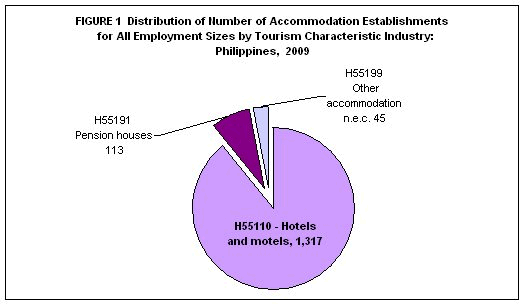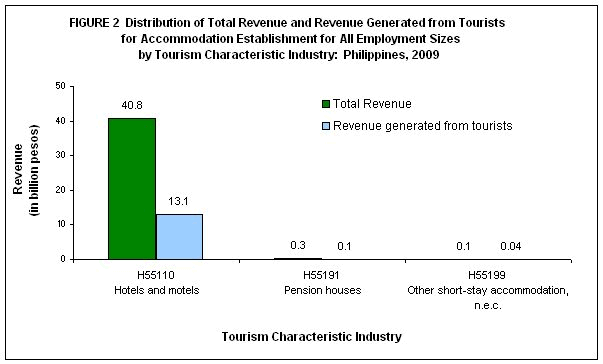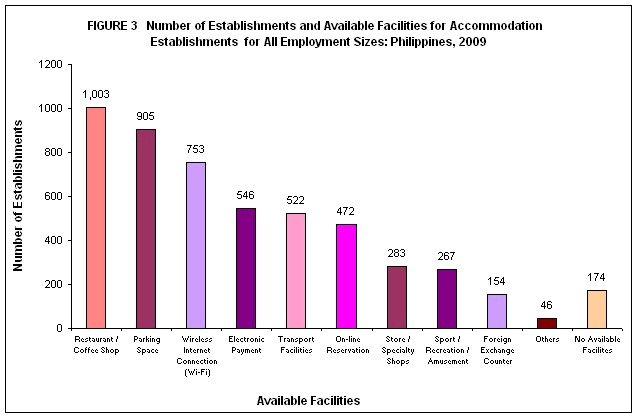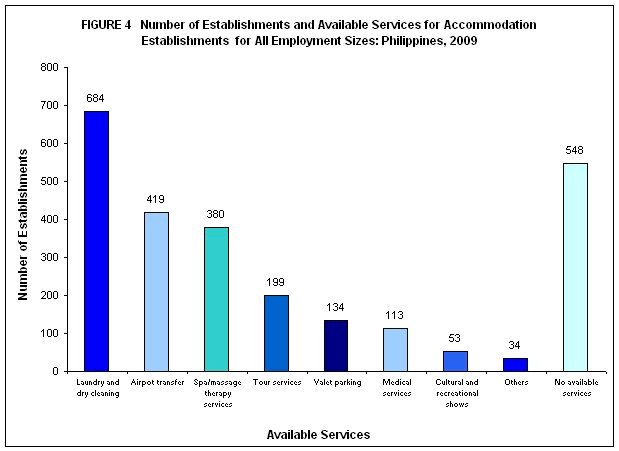Number of Establishments
-
Based on the final results of the 2009 Survey of Tourism Establishment in the Philippines (STEP) conducted nationwide, the Philippines had a total of 1,475 accommodation establishments, 665 or 45.1 percent of which had a total employment of 20 and over while the remaining 810 (54.9%) had a total employment of less than 20. As shown in Figure 1, hotels and motels (H55110) had the most number of establishments with 1,317 or 89.3 percent of the total. Pension houses (H55191) followed with 113 establishments or 7.7 percent while the remaining 3 percent or 45 establishments were engaged in other short-stay accommodation (H55199).

-
On the regional level, National Capital Region (NCR) had the most number of establishments with 290 or 19.7 percent of the total. Western Visayas (Region VI) and Central Visayas (Region VII) tied in second place with 188 or 12.7 percent followed by CALABARZON with 140 or 9.5 percent. Autonomous Region in Muslim Mindanao (ARMM) had the least number with only 3 establishments (0.2%).
Employment
-
Hotels and motels had the highest share in the number of employees with 53,544 employees or 97.1 percent of the total. The remaining 1,606 employees or 2.9 percent were distributed to pension houses and other short-stay accommodation, n.e.c. with 1,110 (2.0%) and 496 (0.9%) respectively.
-
More male workers were employed by accommodation establishments comprising of 33,825 or 61.3 percent of the total. The remaining 21,325 (38.7%) were female employees. For the nationality of the employees, majority were Filipinos with 54,922 employees or 99.6 percent.
-
On the regional level, NCR had the highest share in the number of employees with 17,470 or 31.7 percent of the total. Region VII followed with 8,530 (15.5%), not far behind was Region VI with 6,124 or 11.1 percent while ARMM registered the least with only 157 workers (0.3%). Thirty seven employees was computed as the average number of employees per establishment.
Revenue
-
Top contributor of revenue were hotel and motel (H55110) establishments with PhP40.8 billion or 98.8 percent of the total revenue. Only 1.2 percent of the total revenue was recorded to pension houses (H55191) and other short-stay accommodation n.e.c. (H55199) with 0.8 percent and 0.3 percent respectively. Out of the total revenue, PhP13.3 billion or 32.3 percent were generated from tourists. Shown in Figure 2 is the distribution of revenue and revenue generated from tourists by tourism characteristic industries.
-
Among the regions, NCR contributed more than 50 percent of the revenue with PhP21.5 billion or 52.2 percent. Next in rank was Region VII with PhP6.9 billion (16.6%), followed by Region VI with PhP2.7 billion (6.5%). Other regions which realized over a billion revenues were: Region III, Region IVA, Region IVB and Region XI.

Occupancy Rate in 2009
-
The concentration of average occupancy rate for accommodation establishments was 30 percent or less with 244 (16.5%), followed by 51-60 average occupancy rate with 14.8 percent or 218 establishments. The least average occupancy rate for accommodation establishment was 31-40 percent occupancy rate with 124 establishments or 8.4 percent.
-
For the top three regions in terms of number of establishments, the concentration of average occupancy rate were 61-70 and 71-80 percent for NCR with 51 establishments (17.6%). Region VI followed with 30 percent or less occupancy rate at 30 establishments (16.0%) and Region VII with 37 establishments (19.7%) for both 30 or less and 51-60 average occupancy rates.
Available Facilities
-
For the available facilities found in the accommodation establishments, restaurants/coffee shop had the most number with 1,003 or 68.0 percent, not far behind was parking space with 905 (61.4%) followed by wireless internet connection (Wi-Fi) with 753 or 51.1 percent . See Figure 3 for the available facilities of accommodation establishments.

-
For the front runner regions; NCR, Region VII and Region VI , restaurants/coffee shops offered by hotels and motels were the most available facilities. The least available facilities were sports/recreation/amusement for NCR with 34 or 11.7 percent and foreign exchange counters for both Region VI with 16 (8.5%) and Region VII with 34 establishments (18.1%).
Available Services
-
Accommodation establishments offered a wide range of services to the tourists, the most popular of which was laundry and dry cleaning services with 684 (46.4%), followed by airport transfer with 28.4 percent or 419 establishments. Shown in Figure 4 is the available services offered by accommodation establishments.
-
For NCR, the top services offered by accommodation establishments were laundry and dry cleaning with 112 or 38.6 percent, followed by spa/massage therapy services with 96 or 33.1 percent while the least services offered was cultural and recreational shows with 2 establishments or 0.7 percent only.

Plans for Expansion within the Next Five Years
-
For accommodation establishments, only 292 or 19.8 percent planned to expand within the next five years.
-
For those regions which planned to expand within the next five years the top regions were Region IVA with 37 or 26.4 percent, followed by Region VI and Region VII both with 32 or 17.0 percent and NCR with 31 (10.7%).
Plans for Renovation within the Next Five Years
-
Around 469 (31.8%) accommodation establishments have plans to renovate within the next five years.
-
Top regions were: NCR with 64 (22.1%), next was Region VII with 61 or 32.4 percent, followed by IVA and Region VI both with 54 or 38.6 percent and 28.7 percent respectively.
Department of Tourism (DOT) Accreditation
-
Among the accommodation establishments, only 149 establishments or 10.1 percent were accredited by DOT.
-
With respect to regions, Region VII recorded the highest DOT accreditation with 30 establishments or 16.0 percent followed by NCR with 36 (12.41%) and Region VI with 13 or 6.9 percent
TECHNICAL NOTES
Introduction
The National Statistics Office (NSO) conducted the first-ever 2009 Survey of Tourism Establishments in the Philippines (STEP). This survey collected information on the available supply of tourism goods, products and services which are valuable inputs in the compilation of the Philippine Tourism Satellite Account (PTSA). This is a nationwide survey of establishments in the formal sector engaged in tourism characteristic industries only as defined by Philippine Tourism Statistical Classification System (PTSCS). Tourism characteristic products are goods and services which would cease to exist in meaningful quantity or those for which the level of consumption would be significantly reduced in the absence of visitors (e.g. accommodation services). Activities from which the products were created are termed as tourism characteristic industries.
Scope and coverage
The 2009 STEP is a nationwide survey of establishments in the formal sector engaged in tourism characteristic industries only, as well as, health and wellness industries. Identified industries for health and wellness are included due to the increasing demand for statistics on these activities.
The 2009 STEP covered completely four tourism characteristic industries namely:
-
Hotels and motels (H55110)
-
Pension houses (H55191)
-
Other short-stay accommodation (H55199)
-
Chartered buses and cars operation (I60940)
Also included for scope and coverage of 2009 STEP are those establishments engaged in the following:
-
Accommodation (H55120, H55192)
-
Restaurant (H552)
-
Passenger transport
-
Transport equipment rental
-
Travel agency, tour operator and tourist guide services
-
Recreation, entertainment, cultural services and similar activities
-
Financial and insurance activities
-
Health and wellness
Response rate
A total of 1,649 or or 92.6 percent of the sample establishments responded. These include receipts of "good" questionnaires, partially accomplished questionnaires, and reports of closed, moved out or out of scope establishments.
Concepts and Definition of Terms
Average occupancy rate is the ratio of the number of occupied rooms to the number of available rooms.
Bus is a vehicle with a minimum of 25 seating capacity.
Car/sedan is a vehicle with a minimum seating capacity of five including the driver.
Condotel also known as a hotel-condo and used as both a condominium and a hotel. Condo hotels are typically high-rise buildings developed and operated as luxury hotels, usually in major cities and resort.
Economic activity or business is the activity of the establishment as classified under the amended 1994 Philippine Standard Industrial Classification (PSIC). Generally, the main activity of the establishment is the establishment's principal source of income. If the establishment is engaged in several activities, its main activity is that which earns the biggest income or revenue.
Employment is the number of persons who worked in or for this establishment as of November 15, 2009.
Guestroom is a special room for the guest only.
Hotel is an establishment providing regular reception, accommodation or lodging of travelers and tourists and provision of services incidental thereto for a fee.
Limousine or limo is a luxury vehicle sedan or saloon car, especially one with a lengthened wheelbase or driven by a chauffeur.
Mini-bus is a vehicle with a minimum of 16 to a maximum of 24 seating capacity.
Motorist hotel is an establishment primarily located along the highway with individual or common parking space at which motorists may obtain lodging and in some instances meals.
Pension house is a private or family operated tourist boarding house, tourist guest house or tourist lodging house employing non-professional domestic helper regularly catering to tourist and travelers, containing several independent lettable rooms, providing common facilities such as toilets, bathrooms/shower, living and dining rooms and/or kitchen and were a combination of board and lodging may be provided.
Revenue is the value of goods, products/by-products sold and/or services rendered to others whether paid in cash or is considered receivable by the establishment. Valuation of products/by products sold should be in producer's price (ex-establishment), net of discounts and allowances, including duties and charges but excluding subsidies. It also include goods transferred and/or services rendered to other establishment belonging to the same enterprise as the said establishment which should be treated as sales or as if sold to a customer; and revenue from products on a contractual basis from materials supplied by the establishment.
Resort is an establishment offering food, sleeping, accommodation and recreational facilities to the public for a fee or remuneration.
Resort hotel is a hotel located in a resort area.
Standard room is a hotel industry term for a lower priced and lesser quantity accommodation.
Suite is a perfect lodging choice for business travel and leisure traveler. Corporate travel guests enjoy oversized rooms, mid-priced lodging and others.
Tourism refers to activities of foreign and domestic visitors traveling to and staying in places outside their usual environment for not more than one continuous year for leisure, business and other purposes not related to employment with pay from within the place visited. Traveling for the purpose of conducting business, for education and training, etc. can also be part of tourism. Both foreign visitors (country of residence is other than the Philippines) and domestic visitors (Philippine residents) are covered in the survey.
Tourism activities encompass all that foreign and domestic visitors do for a trip or while on a trip. It is not restricted to what could be considered as "typical" tourism activities such as sightseeing, sunbathing, visiting site, etc. From an economic point of view, the basic activity of foreign and domestic visitors is consumption, that is the acquisition of consumption goods and services to satisfy individual or collective needs and wants.
Tourism characteristic products are goods and services which would cease to exist in meaningful quantity or those for which the level of consumption would be significantly reduced in the absence of visitors. Activities from which the products were created are termed as tourism characteristic industries.
Tourist inn is a lodging establishment catering to transients which does not meet the minimum requirement of an economy hotel.
Source: National Statistics Office
Manila, Philippines
